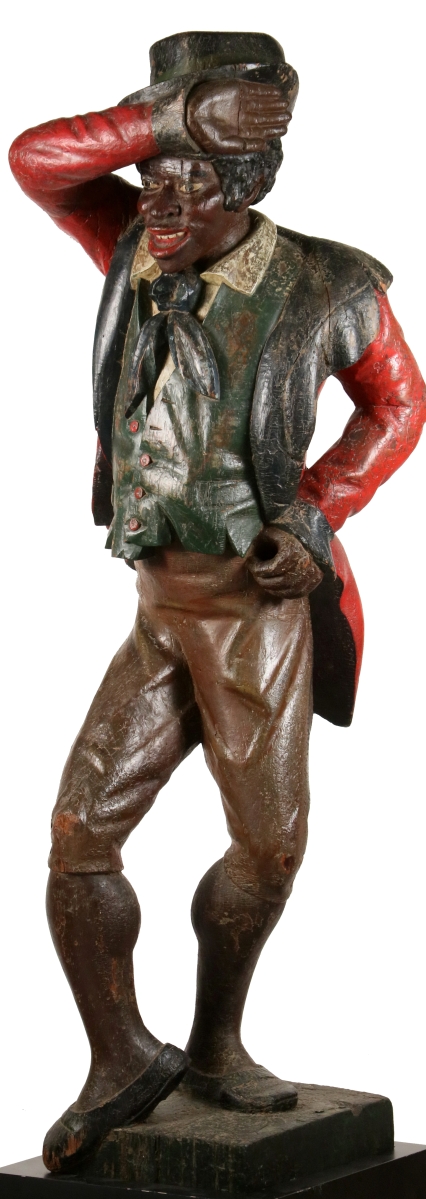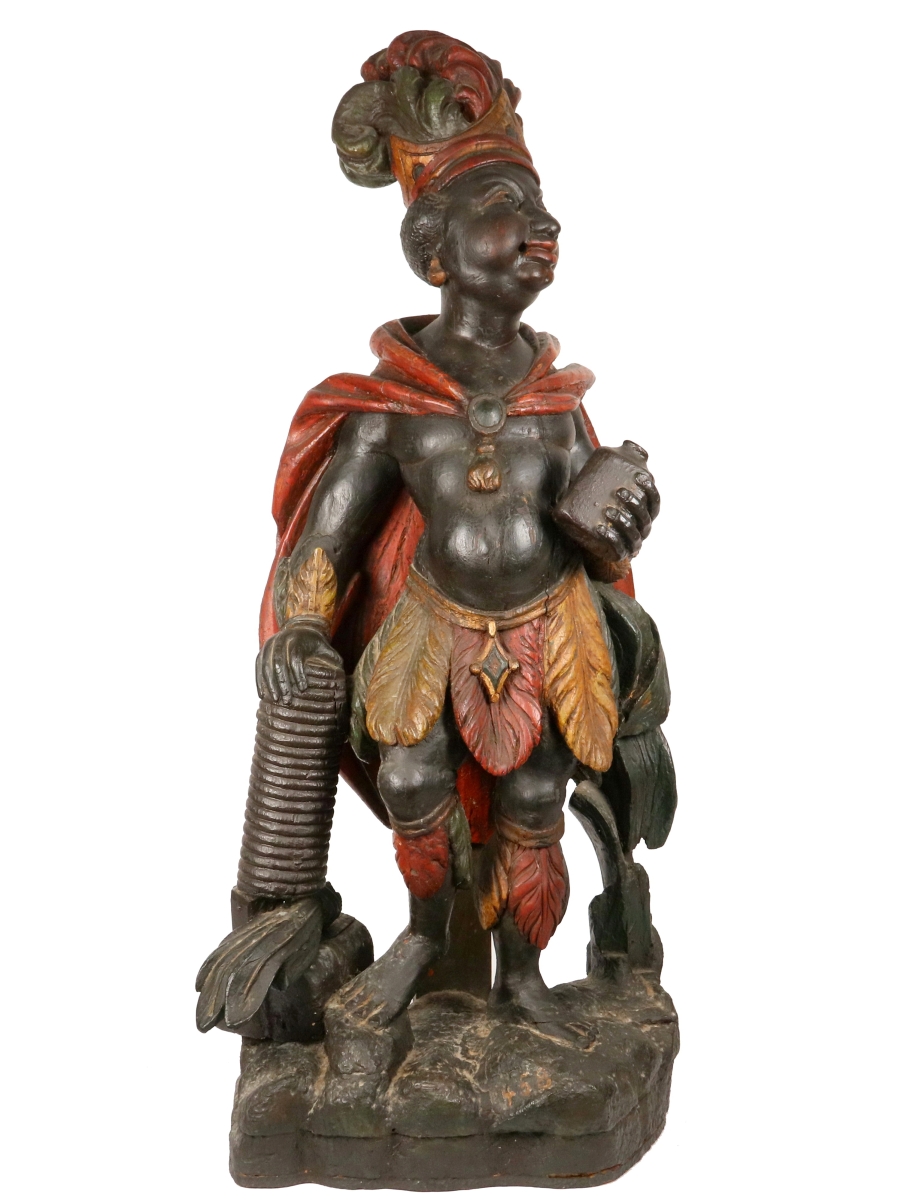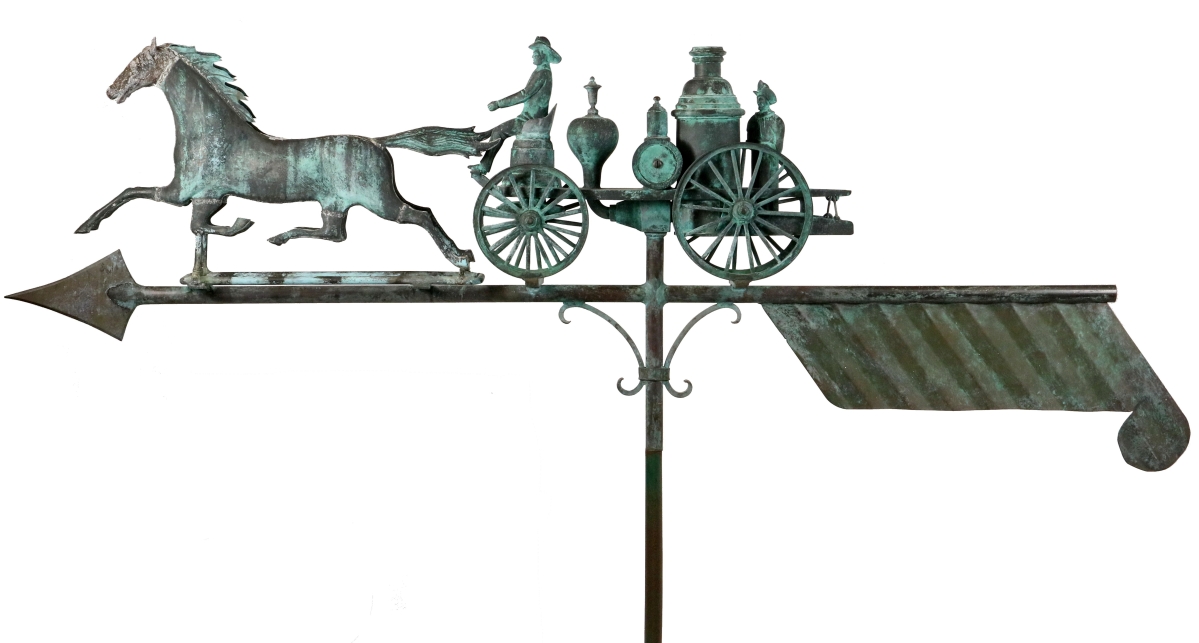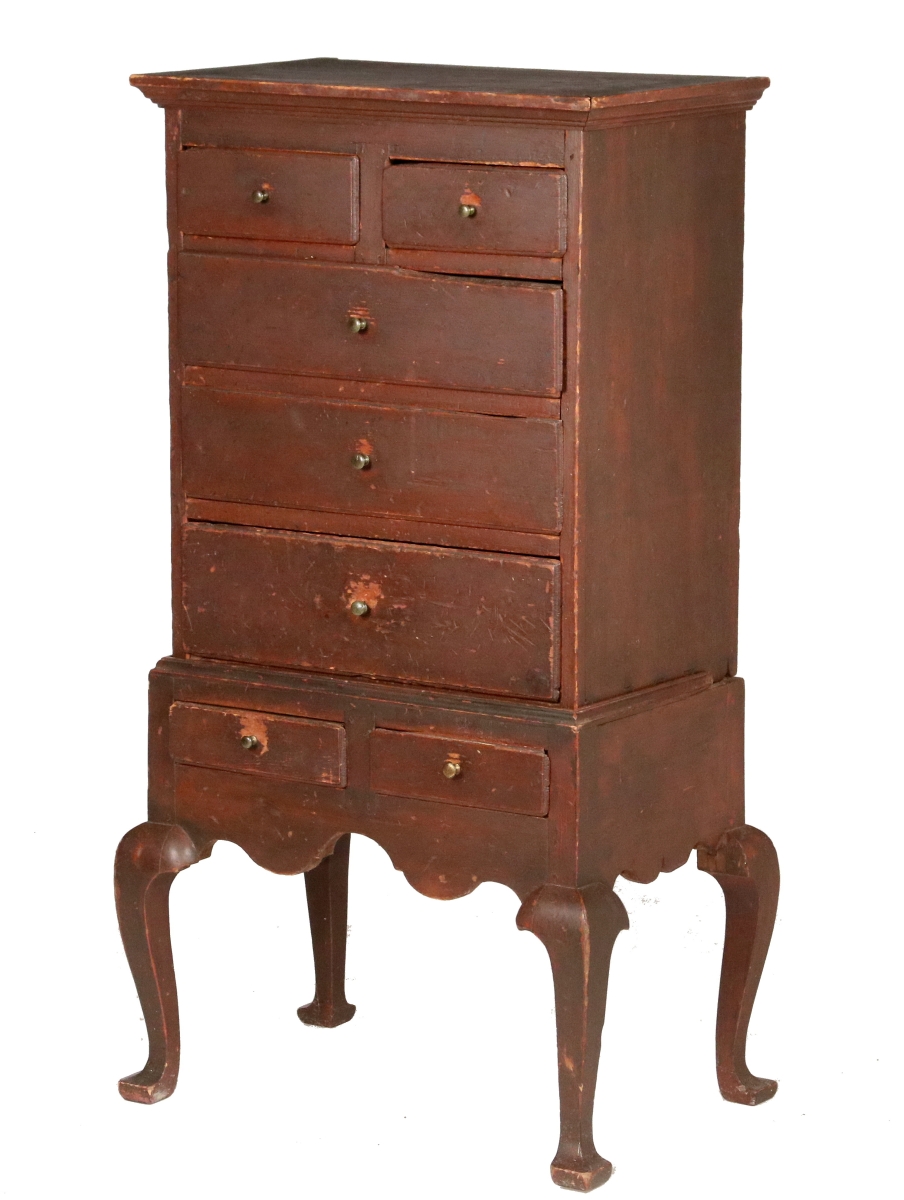Review by Rick Russack, Photos Courtesy of Thomaston Place Auction Galleries

The carved and polychromed figure is said to be “Daddy Rice,” a blackface minstrel performer known for playing the character Jim Crow. His real name was Thomas Dartmouth Rice and he died in 1860. The 52-inch figure was known to have stood on Broadway, outside theaters and tobacco shops. The sale’s top lot at $157,950, it had been exhibited several times in museums, such as the Corcoran Gallery in Washington and the Brooklyn Museum.
THOMASTON, MAINE — As Kaja Veillieux, owner of Thomaston Place Auction Galleries, will be the first to say, conducting a major auction during a blizzard is not the best way to do it. Just 24 inches of snow fell in Thomaston over the weekend of February 11 and 12, but more than 30 inches fell a little south of there — where, of course, bidders from Massachusetts or New Hampshire would be traveling. Nonetheless, the two-day sale grossed more than $1.6 million, led by a wonderful American carved and polychrome wooden minstrel figure, which brought $157,950.
The figure was part of the lifetime collection assembled by Leo Wilensky and comprising 330 lots of folk art, furniture, metalware, paintings and more. It was sold without reserve. The combination of good merchandise and no reserves created a lot of interest. Wilensky was a well-known personality in the antiques world, having been a dealer since 1965 with a particular interest in early American furniture, folk art and lighting. He was known as a world traveler, bringing his customers everything from medieval art to Asian ceramics, along with American material. Several phone lines and internet bidding on three platforms were in use, and there were numerous absentee bids that had been left during the extensively promoted and well-attended preview.
It was expected that a well-known sidewalk trade figure in the form of a minstrel known as “Daddy Rice” or “Jim Crow” would top the auction and it did. The circa 1870 figure is believed to have stood on Broadway, perhaps in front of a theater or tobacco shop and is believed to represent Thomas Danforth Rice (1808–1860), a white American who performed blackface. He was one of the best-known minstrel show performers of his day, and often played “Jim Crow,” a character based on a folk trickster who was popular among black Americans. Rice’s greatest prominence came in the 1830s, and in the 1870s a wooden statue of Rice as Jim Crow was seen in various places along Broadway. The figure is included in the Index of American Design, has been illustrated in Bob Bishop’s Folk Sculpture in America and exhibited at the Corcoran Gallery in Washington. Opinions differ as to who carved the figure.
A second important trade figure carved by William Rush (1756–1833) depicted an American Indian and earned $64,350. The 42-inch figure was probably carved between 1790 and 1810. It may be the earliest surviving carving of a native American used as a tobacco advertisement. It was displayed above the entrance to a shop on Walnut Street in Philadelphia and is described in papers belonging to Rush’s great-grandson. It is illustrated and described in Fred Fried’s Artists in Wood and other books and was shown at the Pennsylvania Academy of Fine Arts in an exhibition devoted to Rush’s sculpture in 1982. According to the Encyclopedia Britannica, Rush is considered to be the first significant American sculptor.
Several pieces of American furniture from the Wilensky collection did well. Of particular interest to folks from Pennsylvania was an untouched Queen Anne child-size two-part highboy in old red paint oxidized to brown. It was described as being circa 1750–70 and from the Delaware Valley. It was only 38 inches tall with a scalloped skirt, tiny brass knobs and well-carved cabriole legs. It sold for $38,610. Also of Pennsylvania interest was a unique hanging cupboard, dated to the Eighteenth Century and believed to have been made in Bucks County, which earned $12,870. It had a single four-light door, shaped end plates, a single shelf and an old painted surface.
Finishing at $8,775 was another hanging cupboard, this one a corner piece, which had also been made in Bucks County in the Eighteenth Century. With traces of original green paint, it had a paneled door over two shelves. It had hung in the governor’s palace in Colonial Williamsburg from 1933 to 1963 and then in Washburne’s Tavern from 1928 to 1980.

William Rush, one of America’s earliest sculptors, carved this native American tobacco advertisement, probably between 1790 and 1810. It was used above the entrance to a shop on Walnut Street in Philadelphia and was included in an exhibition devoted to Rush at the Pennsylvania Academy of Fine Arts in 1982. It earned $64,350.
The Wilensky collection included several interesting pieces of New England and English furniture. Bringing the highest price, $24,570, was an Eighteenth Century Massachusetts cherry highboy. It had a molded, arched bonnet with an inverted shell drop. Attributed to the Amherst-Northampton area and to the workshop of Simeon Pomeroy, it had features similar to known Pomeroy pieces at Historic Deerfield and Amherst College. Selling for $11,115 was a Queen Anne walnut veneered five-drawer shell-front lowboy, possibly from the shop of Joseph Davis, Portsmouth, N.H., circa 1730. Its feet were almost unique to his shop and it had previously been owned by Israel Sack.
An Eighteenth Century pine settle with two drawers in the base, shaped ends and an old brown finish sold for $2,633. It, too, had previously been in the Colonial Williamsburg collections. A Seventeenth Century oak chest with split spindles on four raised bun feet realized $3,744. It had been in the Katherine Prentis Murphy collection and was pictured on the cover of the O. Rundle Gilbert auction catalog when the collection was sold in 1967. The top had been replaced but the original hinges were intact. It reached $3,744. An upholstered bow and braceback Windsor armchair that had been in the Sullivan Dorr house in Providence, R.I., realized $3,510.
An attractive mahogany Eighteenth Century Chippendale fall front writing desk from Rhode Island with a split hinged top went for $7,020. It had a fitted interior, a single drawer below and the brasses may have been original. An interesting Seventeenth Century English oak hall bench with triple linenfold carved back panels, scrolled arms resting on turned posts, a heavy plank seat and with an old surface brought $9,945, nearly doubling the high estimate.
One of the folk art items that was expected to do well was a huge Nineteenth Century American steam pumper fire engine weathervane, probably made by Westervelt Co. It was more than 7 feet long, horse-drawn, made of bronze, copper and zinc, and it had two cast firemen. In good condition, with a nice patina and formerly in the Bronfman collection, it made $55,575.
A fireboard depicting a village with two churches, two men on horseback with hunting dogs, a covered wagon and some exotic animals, achieved $6,435. It was made for the Gabriel Houston House in Sussex County, N.J., circa 1830. A well-documented portrait by Erastus Salisbury Field of his brother brought $12,870. Mary Black, in her book on Field, pictured this portrait and wrote extensively about it, calling it “one of his best portraits.” It had been included in several museum exhibitions. The folk art selections included three of the popular penguins carved by Charles Hart (1896–1960). The largest, 37 inches tall, fetched $4,212.

Probably made by Westevelt, the horse-drawn steam pumper weathervane was made of bronze copper and zinc. It was more than 7 feet long, with a good patina and it sold for $55,575.
The sale included an outstanding centennial quilt, fine hooked rugs and some good needlework. The central panel of a quilt dated 1876 was a marriage scene outside a church. The surrounding 12 panels each depicted a New England-style house with people out in front. Centered at the top, a man waves an American flag dated 1876. It sold for $19,890.
Wilensky had good taste in hooked rugs and some unusual examples were available in this sale. A circa 1860 rug with more than two dozen figurative panels earned $7,020. Most of the panels depicted animals — sheep, chickens, starfish, frogs, dogs, horses, etc, plus hearts and bull’s-eyes. It had been pictured in the Architectural Digest in 1993. A rug with an unusual scene, depicting a leopard (?) roaming through the jungle brought $2,223, while another one, with a tiger (?) under a pink sky brought only $351. Another rug depicted a whimsical blue house cat seated on a blue, brown and tan striped background. It was initialed Z.H.G. and I.F.M. and included a date of 1835. It would seem that cats bring more than leopards or tigers, as this rug earned $2,340. A needlework memorial to George Washington, signed by Cynthia Bushnell Wilcox and dated 1804, reached $5,265.
Leo Wilensky liked early metal objects and was well known for selling them. Many examples were bought during trips to Europe. Of interest to buyers was a selection of early bronze mortars and pestles, several of which were signed and dated: one signed John Care and dated 1656 (the year of the Great Plague of London), sold for $2,691. Another, signed and dated William Oldfield, York, 1637, went for just a little less, $2,574. A pair of 8½-inch forged iron candlesticks with drip pans, cataloged as Seventeenth Century, sold for $1,287. An outstanding Queen Anne brass and wrought iron adjustable height double candlestand, dated to 1730–50 and probably made in Boston, finished at $12,870. It had been owned by Frank Walton, past president of the Rushlight Club.

Cataloged as originating in the Delaware Valley, this child-size miniature highboy earned $38,610. In old red paint, it was 38 inches tall, had tiny brasses and was dated circa 1750–70.
An important liquor chest with a significant historical association had previously been in the Eddy Nicholson collection and was sold at Christie’s in 1995. The chest reputedly belonged to Commodore William Bainbridge, who commanded the USS Constitution during the War of 1812. The fitted interior retained eight large and two small hand-blown, gilt decorated bottles. The inside of the lid had an etched mirror depicting an American eagle with “E Pluribus Unum.” The catalog speculates that the chest may have been on board the Constitution at the time of Bainbridge’s epic victory over HMS Java.
Several paintings did well. A painting of a winter farm scene, reminiscent of Currier and Ives, described as by “a member of the Durrie family,” went for $17,550. A Boston street scene, titled “Scollay Square Boston,” 1927, painted by Harry Irving Shumway, (American, 1883-1974), went out at $4,797. There were four paintings attributed to Thomas Chambers (American, 1806–1888). Two failed to meet the reserve, but the other two sold. Bringing $12,870 was a scene of New York Harbor showing Castle William, and bringing $11,170 was a scene of Washington’s Mount Vernon, on neglected grounds with a side-wheeler in the distant Potomac River.
The sale included nearly 1,000 varied lots, several of which are worth noting. A large eastern woodlands oval maple burl bowl with carved and pierced handles earned $4,680 in spite of some old repairs. A white presentation fire helmet with a painted front plate depicting a steam pumper was marked Chief and OFD. An engraved brass plate read “Presented to R.G. Blackburn, Chief, Oswego Fire Dept., by the Life Saving Corps, N.Y.F.D.” It went for $4,680. A rare and unusual Seventeenth Century Wrotham ware covered posset pot with a brown slip glaze and applied tree form decoration realized $8,190. The ware is named for the village of Wrotham, in Kent, although it was also made in surrounding villages. Posset pots were designed for the consumption of a warm, spiced drink, popular in medieval times. Posset was sometimes given to new mothers to strengthen them and others recovering from illnesses.
After the sale, Kaja Veillieux said that although the sale was successful, “I’m sure the storm really hurt prices. We usually have larger crowds in the gallery. But I was glad to find new homes for the two trade figures and some other things like the miniature Pennsylvania highboy.” He added that some things that did not sell were also a surprise, such as two Soap Hollow paint-decorated chests with provenance from the Strong Museum, Rochester, N.Y. “There’s been some interest in them and they may still sell,” he said.
All prices reported include the buyer’s premium.
For additional information, www.thomastonauction.com or 207-354-8141.


























